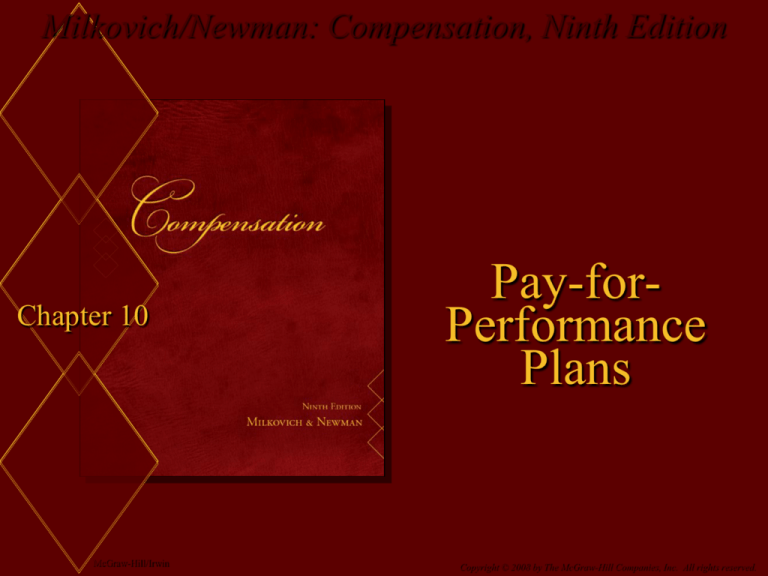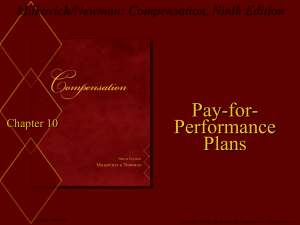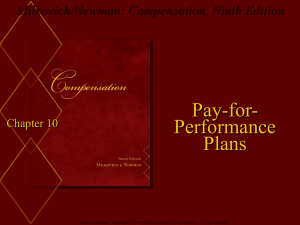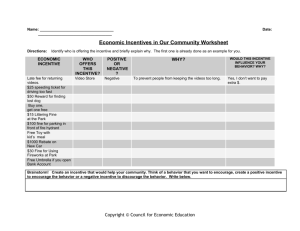
Milkovich/Newman: Compensation, Ninth Edition
Chapter 10
McGraw-Hill/Irwin
Pay-forPerformance
Plans
Copyright © 2008 by The McGraw-Hill Companies, Inc. All rights reserved.
What Is Pay-for-Performance?
Pay for performance plans signal
a movement away from
entitlements
Pay will vary with some measure
of individual, team, or
organizational performance
10-2
Exhibit 10.1: Use of Different
Variable-Pay-Plan Types
10-3
Exhibit 10.2: Base vs. Variable Pay
10-4
Specific Pay-for-Performance Plans:
Short Term
Merit Pay
Lump-Sum Bonuses
Individual Spot Awards
Individual Incentive Plans
10-5
Managing Merit Pay
Improve accuracy of performance ratings
Allocate enough money to truly reward
performance
Make sure size of merit increase differentiates
across performance levels
10-6
Exhibit 10.4: Customer Service Bonus
Scheme
10-7
Exhibit 10.5: Individual Incentive Plans
10-8
Exhibit 10.7: A Straight Piece Rate Plan
10-9
Advantages of
Individualized Incentive Plans
Substantial
contribution to:
– Productivity raise
– Lower production costs
– Workers earnings
Reduces
direct supervision to maintain
reasonable output levels
Enables
labor costs to be estimated more
accurately than under payment by time
– Helps costing and budgetary control
10-10
Disadvantages of
Individualized Incentive Plans
Conflicts
may emerge between employees and
managers
Introduction of
new technology may be resisted
by employees
Reduced
willingness of employees to suggest
new production methods
Increased
complaints of poor maintenance,
hindering employee efforts to earn larger
incentives
10-11
Disadvantages of
Individualized Incentive Plans (cont.)
Increased
turnover among new employees
discouraged by the unwillingness of experienced
workers to cooperate in on-the-job training
Elevated
levels of mistrust between workers and
management
10-12
Exhibit 10.10: Lincoln Electric’s
Compensation System
10-13
Exhibit 10.11: A Sampling of Performance Measures
10-14
Balanced Scorecard Approach
Uses
a constellation of measures
– Pinpoints areas of success
– Indicates areas to improve
Categories
of measures
– Financial results
– Process improvements
– Customer service
– Innovation
10-15
Balanced Scorecard Approach (cont.)
Forces discussions about priorities among
different measures
Outcome – Objectives with different weights in
terms of importance
10-16
Exhibit 10.12: Types of Variable Pay Plans: Advantages and
Disadvantages
10-17
Exhibit 10.12: Types of Variable Pay Plans:
Advantages and Disadvantages-con’t
10-18
Exhibit 10.13: The Choice Between
Individual and Group Plans
10-19
Key Elements in Designing
a Gain-Sharing Plan
Strength of reinforcement
Productivity standards
Sharing the gains
Scope of the formula
Perceived fairness of the formula
Ease of administration
Production variability
10-20
Types of Gain-Sharing Plans
Implementation of
Scanlon/Rucker Plans
– Two major components are vital to implementation
and success
Productivity norm
Effective worker committees
10-21
Exhibit 10.14: Three Gain-Sharing
Formulas
10-22
Profit-Sharing Plans
Predetermined index of profitability
– Employees may not feel their jobs directly impact
profits
The trend in recent variable-pay design is to
combine the best of gain-sharing and profitsharing plans
– The plan must be self funding
– Along with having the financial incentive,
employees feel they have a measure of control
10-23
Earnings-at-Risk Plans
Success
sharing plan
– Employee base pay is constant
Variable pay increases in successful years
No reduction in base pay and no variable pay in poorlyperforming years
Risk
sharing plan
– Employee base pay varies
Base pay often reduced in poor performance years
Shifts part of risk of doing business from company to
employee
10-24
Exhibit 10.16: Group Incentive Plans:
Advantages and Disadvantages
10-25
Example of Group
Incentive Plan - Saturn
Earnings-at-risk plan where base pay is 93% of
market
Employees meet individual objectives to capture
at-risk component
All team members must meet objectives for any
to get at-risk money
A profit sharing component is based on
corporate profits
10-29
Group Incentive Plans: Examples
All incentive plans can be described by common
features
– The size of the group that participates in the plan
– The standard against which performance is
compared
– The payout schedule
10-31
Explosive Interest in Long-term
Incentive Plans
Long-term incentives (LTIs) focus on
performance beyond the one-year time line used
as the cutoff for short-term incentive plans
Recent explosive growth in long term plans is
spurred in part by a desire to motivate longerterm value creation
10-32
Long-Term Incentive Plans
Employee Stock Ownership Plans
(ESOPs)
Performance Plans (Performance
Share and Performance Unit)
Broad-Based Option Plans (BBOPs)
10-33
Exhibit 10.18: Long-Term Incentives and
Their Risk/Reward Tradeoffs
10-34










